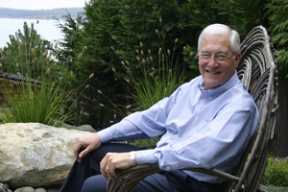Start saving and stick to a long-term strategy to ‘live it up,’ Merriman says.
When it comes to investing for a secure retirement, overcoming one’s knee jerk fears may be harder than actually saving money.
“I’m convinced the hurdles we have to becoming successful investors are psychological,†said islander Paul Merriman, who recently published his third book, “Live It Up Without Outliving Your Money†about retirement investment.
“When you’re feeling safe (because the market’s high), it’s risky,†Merriman said. “When the market is low, your feeling is low, but the financial risk is low.â€
Merriman has been in finance for nearly 40 years and is president of an investment advisory firm, Merriman Capital Management, which manages $850 million in investments for its clients.
He has a weekly radio broadcast and a webcast show, and conducts workshops and lectures.
Merriman said he hopes his book will enable people to put together a portfolio that will take them through retirement.
The book provides a framework to start an investment portfolio that doesn’t begin with eye-glazing financial terms, and continues through to how to take withdrawals without prematurely sapping your funds.
And, Merriman said, it’s possible to end up with a multimillion dollar retirement portfolio for your child by starting out saving a dollar a day until he or she is 30, if your child continues from that point.
Merriman’s advice for reaching the “perfect portfolio†is based on academic research and not Wall Street, which “does a lot to get people not to do things in our best interest.â€
To start, he cautions against letting stockbrokers plan your investment. Unlike lawyers or accountants, Merriman said, stockbrokers are salespeople who are under pressure to sell; thus, they may not recommend actions in your best interest.
“The reality is there are a lot of things to mistrust even without the Enrons,†Merriman said. “The focus here is what can you trust?
“If you could just get market returns, you’ll do fine. You don’t have to break the bank.â€
Although a trustworthy, independent advisor – and the book discusses how to select one – can help choose funds to invest in, the work begins with “knowing who you are.†That is, how much you will need a year to live on or “live it upâ€; what income sources you’ll have and thus how much your portfolio has to kick in; and, most importantly, finding your level of risk tolerance.
Choosing a portfolio with an acceptable risk tolerance – how much money you can stand to lose in one year – is important, as too large a loss can cause an investor to panic and pull out of a well-made plan and lose out on potential returns – which are based on keeping to the plan for more than just five or 10 years.
“We want to be as diligent as we can about taking care of our own money,†Merriman said, comparing ceding retirement decisions to advisors to handing financial responsibility for one’s own business to another person.
To that end, a good chunk of the book takes the reader step by step through Merriman’s reasoning for why his recommended allocation of assets is the “perfect portfolio,†which maximizes returns while weathering short-term ups and downs, i.e., minimizing risk.
A discussion of taxes and expenses exposes “leaks†that deprive the investor early on of dollars that might otherwise be earning money.
Merriman defines technical terms as they come up and and includes many historical tables and examples to illustrate his points, which are easy to follow for the layperson.
And, although past performance of a fund does not guarantee future performance, Merriman’s book points out that it is a good indicator of future volatility and thus risk.
“It’s not a question of if past returns are meaningful, but what is statistically relevant?†Merriman said.
From 1995-99, the Standard and Poor’s 500 – a basket of 500 stocks of medium to large firms that gives a snapshot of the stock market’s value – returned a high 28.5 percent.
Consider that from 1926-1994, the S&P 500 returned about 10.3 to 10.4 percent, but even adding those upturn years, 1926-2002 returned 10.4 percent.
The unusually high returns from 1995-99 don’t even register as a blip.
So, after doing the intellectual self-analysis homework and setting up the portfolio – either by yourself or with an advisor – Merriman recommends staying the course by putting the portfolio “on automatic.â€
Yearly IRA contributions on the same date and scheduled rebalancing will take the misleading emotional impulses — to buy too much or little — out of the portfolio’s maintenance.
“The things that are counterintuitive are in your best interest,†Merriman said.
Emotionally, no one wants to invest in “unexcellent†companies that perhaps suffered recent missteps, called the “value†asset class, preferring the “growth†class of “hot†companies full of potential.
Yet, “over 80 years, value has out performed growth,†Merriman said.
“If you allow the industry to get to you, it will get you to do things that aren’t in your interest.â€
* * * * *
Money matters
Bainbridge Island author Paul Merriman reads from his book “Live It Up Without Outliving Your Money†at 7:30 p.m. Sept. 8 at Eagle Harbor Books. See www.fundadvice.com for his newsletter, articles and workshop information. For more information on the book reading, call 842-5332.


